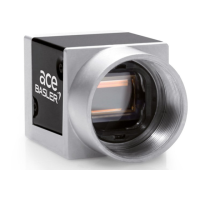AW00097603000 I/O Control
Basler aviator GigE 53
6.2.4 Working with the Timer Output Signals
As mentioned in Section 6.2.1 on page 49, the source signal for each output line can be set to "timer
active". The camera has four timers: timer 1, timer 2, timer 3, and timer 4. When you set the source
signal for an output line to "timer active", the correspondingly numbered timer will be used to supply
the signal to the output line. For example, if you decide that you want to use "timer active" as the
source signal for output line 3, then timer 3 will supply the source signal for the output.
The timer output signals all operate in an identical fashion. They operate as follows:
A trigger source event occurs that starts the timer.
A delay period begins to expire.
When the delay expires, the timer signal goes high and a duration period begins to expire.
When the duration period expires, the timer signal goes low.
Currently, the only trigger source event available to start the timer is "exposure start". In other
words, you can use exposure start to trigger the start of the timer.
If you require the timer signal to be high when the timer is triggered and to go low when the delay
expires, simply set the output line to invert.
6.2.4.1 Setting the Trigger Source for a Timer
To set the trigger source for a timer:
Use the Timer Selector to select the timer.
Set the value of the Timer Trigger Source parameter to exposure active. This will set the
selected timer to use the start of exposure to begin the timer.
You can set the Trigger Selector and the Timer Trigger Source parameter value from within your
application software by using the Basler pylon API. The following code snippet illustrates using the
API to set the selector and the parameter value for timer 1:
Camera.TimerSelector.SetValue( TimerSelector_Timer1 );
Camera.TimerTriggerSource.SetValue( TimerTriggerSource_ExposureStart );
You can also use the Basler pylon Viewer application to easily set the parameters.
For more information about the pylon API and the pylon Viewer, see Section 3 on page 21.

